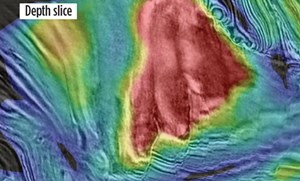What's new in exploration
The other day, while driving along Interstate 10 in Houston, I noticed a dozen buzzards circling the BP building. I did not know things were that bad over there.
Crowding the stage. Wayne Christian, chairman of the Texas Railroad Commission, told the World Oil Forecast Breakfast 2020 audience (Jan. 31) that the industry is pursing renewables at more than 2x upside down while letting profitable exploration businesses flag, because we mistakenly seek political approval. Meanwhile, a PBS NOVA presentation, “Polar Extremes,” exhibited anecdotals taken from active data collections around the globe, combined with interpretations and presumptions establishing a theory on the Carbon Cycle. It used hot and iced dating before Pre-Cambrian, explaining that our planet was completely covered with ice more than once, even within the concept of modern plate tectonics.
Data examples were all about CO2, using fossils and paleo-mud. Contributing today were autos, power plants, volcanoes and perma-frost, releasing previously naturally captured CO2 and methane. Evidence shows pre-man CO2 levels higher than ominous future predictions. CO2 was easily reduced by simple rain, with only a slight PH decrease contributing to marine carbonate formation. Explaining data from the last 150 years [our oil exploration window] repeated the standard, humanity is creating a crisis. Facts might help greenies take a breath, but NOVA still calls for CO2 reductions now, or lose nature’s ice with other horrible outcomes.
But do we collectively want to? How fast? Renewables are very limited in scope and power. Earth’s population is mega-concentrated in large cities. If the New Green Deal, as proposed, is instituted over the next decade by any country, the lucky ones under that plan will become slaves to poverty. Eighty percent could likely die from anarchy or starvation, while politicians remain fat and secure behind walls. Wasn’t a movie made about this?
Exploration on stage. ExxonMobil is taking a beating in the stock market but not at the wellhead, as evidenced by ExxonMobil’s 16th discovery in the waters offshore Guyana in the Stabroek Block, 10 mi northeast of Liza field. Chevron is giving up, following everyone, everywhere, by abandoning Appalachia at a writedown of over $6 billion. Shell will spend a few billion dollars/year more on Permian shale, BUT Shell is working to decarbonize, transforming to a low-carbon business selling “newer” energies. BP is spending significant dollars to reach zero carbon emissions by 2050. Euro oil is under extreme pressure by the EU to “transition” away from fossil fuels. Yet, oil is the only reason that the EU is still afloat. I note financial CPR is being performed on U.S. shale patients while offshore activity is showing life, especially in South America, West Africa, the GOM and the North Sea.
“If what you do is such a good idea, why isn’t everyone there?” History is of value, but if the answer is based on someone else’s exploration, chances are they already own the best nuggets. I suspect “money” does not understand exploration risk or language. Observe tech speak below, in a recent article on advanced seismic.
“Solving Trinidad’s Imaging Challenges Through Orthorhombic and Least Squares Q Migration of High-density Full-azimuth OBN Data,” Kareem Vincent, et. al, including Imtiaz Ahmed and Hu Jin, BP, Fig. 1.
Trinidad is known to be a difficult area for seismic imaging. To start with, the structure is complex, and acoustic data is strongly absorbed by shallow gas. Compounding this is the presence of strong azimuthal anisotropy. With these issues in mind, BP Trinidad and Tobago acquired a high-density full-azimuth OBN survey in 2016-2017 and processed it with an orthorhombic velocity model to address the azimuthal anisotropy and a least squares Q migration to compensate for the attenuation. They believe this represents a significant step-change in image quality and depth accuracy. Geophysical Society of Houston, Journal, January 2020, pp 14-21.
Translation of the above:
a. Least squares Q is a statistical method applied to calculating estimates of a physical property of a medium, Q, to absorb, or attenuate seismic energy into another form of energy, heat. Seismic methods in oil do not generate enough heat at depth to cook anything, but the idea of Q has become a number for indirect measurement of rock elasticity, with and without fluids.
b. Azimuthal anisotropy is a broad term for non-homogeneous variances in subsurface acoustic properties and derivatives, due to direction often thought of in the x or y sense, but includes depth, z.
c. Full azimuth is a generalized term for spreading receivers on a surface plane about as wide as equipment will let you, and still find signal that is higher amplitude than noise. Usually sought for illuminating under objects such as salt, or for recording lower frequencies used to interpret rock physics characteristics.
d. OBN is trade lingo for Ocean Bottom seismic, using recording nodes that are independent of cables.
e. Orthorhombic velocity is a new understanding of velocity behavior directionally, with respect to fractures/faults where both P and S waves behave differently with respect to parallel or perpendicular orientation to the fractures/faults.
Not exactly coffee room speak of money in and money out.
- Applying ultra-deep LWD resistivity technology successfully in a SAGD operation (May 2019)
- Adoption of wireless intelligent completions advances (May 2019)
- Majors double down as takeaway crunch eases (April 2019)
- What’s new in well logging and formation evaluation (April 2019)
- Qualification of a 20,000-psi subsea BOP: A collaborative approach (February 2019)
- ConocoPhillips’ Greg Leveille sees rapid trajectory of technical advancement continuing (February 2019)



